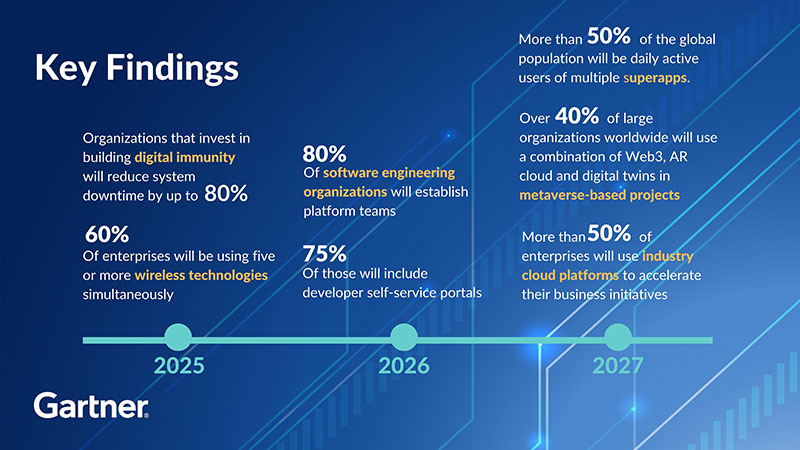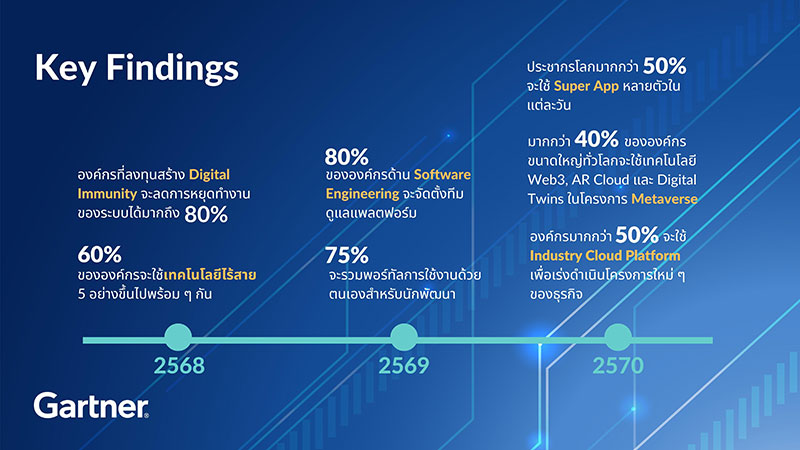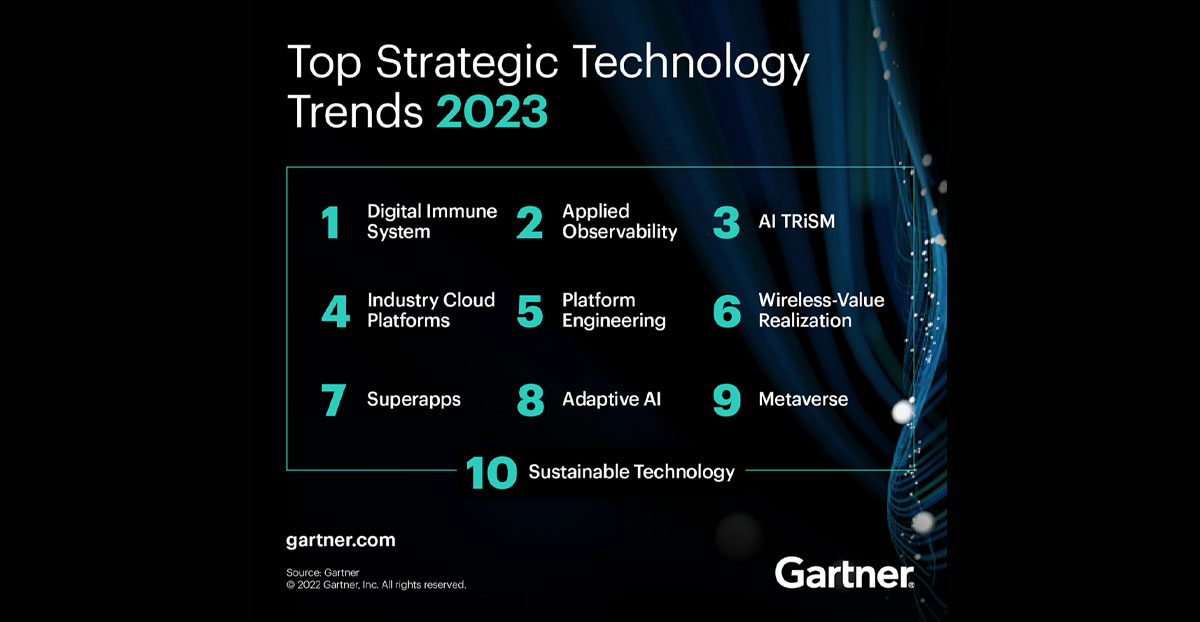Gartner, Inc. announced its list of 10 top strategic technology trends that organizations need to explore in 2023.
“To enhance their organization’s financial position during times of economic turbulence, CIOs and IT executives must look beyond cost savings to new forms of operational excellence while continuing to accelerate digital transformation,” said Frances Karamouzis, Distinguished VP Analyst at Gartner. “The Gartner strategic technology trends for 2023 are built around three themes — optimize, scale and pioneer — where technologies can help organizations optimize resilience, operations or trust, scale vertical solutions and product delivery, and pioneer with new forms of engagement, accelerated responses or opportunity.”
“However, in 2023, delivering technology will not be enough. These themes are impacted by environmental, social and governance (ESG) expectations and regulations, which translate into the shared responsibility to apply sustainable technologies. Every technology investment will need to be set off against its impact on the environment, keeping future generations in mind. ‘Sustainable by default’ as an objective requires sustainable technology,” said David Groombridge, Distinguished VP Analyst at Gartner.
The top strategic technology trends for 2023 are:
Sustainability
Sustainability traverses all of the strategic technology trends for 2023. In a recent Gartner survey, CEOs reported that environmental and social changes are now a top three priority for investors, after profit and revenue. This means that executives must invest more in innovative solutions that are designed to address ESG demand to meet sustainability goals. To do this, organizations need a new sustainable technology framework that increases the energy and material efficiency of IT services, enables enterprise sustainability through technologies like traceability, analytics, renewable energy and AI, and deploys IT solutions to help customers achieve their own sustainability goals.
Pioneer
Metaverse
Gartner defines a metaverse as a collective virtual 3D shared space, created by the convergence of virtually enhanced physical and digital reality. A metaverse is persistent, providing enhanced immersive experiences. Gartner expects that a complete metaverse will be device-independent and won’t be owned by a single vendor. It will have a virtual economy of itself, enabled by digital currencies and non-fungible tokens (NFTs). By 2027, Gartner predicts that over 40% of large organizations worldwide will use a combination of Web3, AR cloud and digital twins in metaverse-based projects aimed at increasing revenue.
Superapps
A superapp combines the features of an app, a platform and an ecosystem in one application. It not only has its own set of functionalities, but it also provides a platform for third parties to develop and publish their own mini-apps on. By 2027, Gartner predicts that more than 50% of the global population will be daily active users of multiple superapps.
“Although most examples of superapps are mobile apps, the concept can also be applied to desktop client applications, such as Microsoft Teams and Slack, with the key being that a superapp can consolidate and replace multiple apps for customer or employee use,” said Karamouzis.
Adaptive AI
Adaptive AI systems aim to continuously retrain models and learn within runtime and development environments based on new data to adapt quickly to changes in real-world circumstances that were not foreseen or available during initial development. They use real-time feedback to change their learning dynamically and adjust goals. This makes them suitable for operations where rapid changes in the external environment or changing enterprise goals require an optimized response.
Optimize
Digital Immune System
Seventy-six percent of teams responsible for digital products are now also responsible for revenue generation. CIOs are looking for new practices and approaches that their teams can adopt to deliver that high business value, along with mitigating risk and increasing customer satisfaction. A digital immune system provides such a roadmap.
Digital immunity combines data-driven insight into operations, automated and extreme testing, automated incident resolution, software engineering within IT operations and security in the application supply chain to increase the resilience and stability of systems. Gartner predicts that by 2025, organizations that invest in building digital immunity will reduce system downtime by up to 80% – and that translates directly into higher revenue.
Applied Observability
Observable data reflects the digitized artifacts, such as logs, traces, API calls, dwell time, downloads and file transfers, that appear when any stakeholder takes any kind of action. Applied observability feeds these observable artifacts back in a highly orchestrated and integrated approach to accelerate organizational decision-making.
“Applied observability enables organizations to exploit their data artifacts for competitive advantage,” said Karamouzis “It is powerful because it elevates the strategic importance of the right data at the right time for rapid action based on confirmed stakeholder actions, rather than intentions. When planned strategically and executed successfully, applied observability is the most powerful source of data-driven decision-making.”
AI Trust, Risk and Security Management
Many organizations are not well prepared to manage AI risks. A Gartner survey in the U.S, U.K. and Germany found that 41% of organizations had experienced an AI privacy breach or security incident. However, that same survey found that organizations that actively managed AI risk, privacy and security achieved improved AI project results. More of their AI projects moved from proof-of-concept status into production and achieved more business value than did AI projects in organizations that did not actively manage these functions.
Organizations must implement new capabilities to ensure model reliability, trustworthiness, security and data protection. AI trust, risk and security management (TRiSM) requires participants from different business units to work together to implement new measures.
Scale
Industry Cloud Platforms
Industry cloud platforms offer a combination of SaaS, platform as a service (PaaS) and infrastructure as a service (IaaS) providing industry-specific sets of modular capabilities to support specific industry business use cases. Enterprises can use the packaged capabilities of industry cloud platforms as building blocks to compose unique and differentiating digital business initiatives, providing agility, innovation and reduced time to market, while avoiding lock-in.
By 2027, Gartner predicts that more than 50% of enterprises will use industry cloud platforms to accelerate their business initiatives.
Platform Engineering
Platform engineering is the discipline of building and operating self-service internal developer platforms for software delivery and life cycle management. The goal of platform engineering is to optimize the developer experience and accelerate product teams’ delivery of customer value.
Gartner predicts that 80% of software engineering organizations will establish platform teams by 2026 and that 75% of those will include developer self-service portals.
Wireless Value Realization
While no single technology will dominate, enterprises will use a spectrum of wireless solutions to cater for all environments, from Wi-Fi in the office, through services for mobile devices, to low-power services and even radio connectivity. Gartner predicts that by 2025, 60% of enterprises will be using five or more wireless technologies simultaneously.
As networks move beyond pure connectivity, they will provide insight using built-in analysis and low-power systems will harvest energy directly from the network. This means the network will become a source of direct business value.
This year’s top strategic technology trends highlight those trends that will drive significant disruption and opportunity over the next five to 10 years. Gartner clients can read more in the Gartner Special Report “Top Strategic Technology Trends for 2023.”

การ์ทเนอร์ อิงค์ ประกาศ 10 เทรนด์เทคโนโลยีมาแรงที่องค์กรธุรกิจต้องจับตาและศึกษา เพื่อรับมือกับการเปลี่ยนแปลงในปี 2566
ฟราสซิส คารามูซิส รองประธานฝ่ายวิจัยการ์ทเนอร์ กล่าวว่า “เพื่อยกระดับสถานะทางการเงินในช่วงเศรษฐกิจผันผวนขององค์กร ผู้บริหารและผู้นำด้านไอทีทั้งหลายต้องมองการณ์ไกลกว่าแค่การประหยัดต้นทุนไปสู่รูปแบบการดำเนินงานที่มีประสิทธิภาพใหม่ ๆ ขณะเดียวกันก็ต้องเร่งการทำดิจิทัล ทรานส์ฟอร์มเมชันอย่างต่อเนื่อง โดยแนวโน้มเทคโนโลยีเชิงกลยุทธ์ที่มาแรงในปี 2566 จะพัฒนาขึ้นมาจากสามธีมหลัก ได้แก่ การเพิ่มประสิทธิภาพ (Optimize) การปรับขยาย (Scale) และการเป็นผู้ริเริ่ม (Pioneer) ที่เทคโนโลยีสามารถช่วยองค์กรธุรกิจเพิ่มประสิทธิภาพความยืดหยุ่นในการดำเนินงานหรือสร้างความเชื่อมั่น พร้อมปรับขยายโซลูชันและส่งมอบผลิตภัณฑ์ที่มีความเฉพาะ และริเริ่มรูปแบบการมีส่วนร่วม การตอบสนองใหม่ ๆ ที่รวดเร็ว หรือสร้างโอกาสให้ธุรกิจได้”
เดวิด กรูมบริดจ์ นักวิจัยอาวุโสของการ์ทเนอร์ กล่าวว่า “อย่างไรก็ตามในปีหน้านี้ การส่งมอบเทคโนโลยีจะไม่เพียงพออีกต่อไป เนื่องด้วยธีมเหล่านี้ต่างได้รับผลกระทบจากความคาดหวังและกฎระเบียบด้านสิ่งแวดล้อม สังคม และธรรมาภิบาล (หรือ ESG) ซึ่งหมายถึงความรับผิดชอบร่วมกันในการใช้เทคโนโลยีอย่างยั่งยืน ในทุกการลงทุนทางเทคโนโลยีจะต้องไม่ส่งผลกระทบต่อสิ่งแวดล้อม และต้องคำนึงถึงคนรุ่นต่อ ๆ ไปในอนาคต “Sustainable by Default หรือความยั่งยืนเป็นพื้นฐาน” เป็นเป้าหมายในการนำเทคโนโลยียั่งยืนมาใช้”
10 แนวโน้มเทคโนโลยีเชิงกลยุทธ์ที่มาแรงในปี 2566 มีดังนี้
ความยั่งยืน (Sustainability)
ความยั่งยืนครอบคลุมเทรนด์เทคโนโลยีเชิงกลยุทธ์ทั้งหมดในปี 2566 จากการสำรวจของการ์ทเนอร์ เมื่อเร็ว ๆ นี้ ชี้ให้เห็นว่าผู้บริหารไอทีมองว่าการเปลี่ยนแปลงด้านสิ่งแวดล้อมและสังคมในขณะนี้มีความสำคัญสูงสุดติดสามอันดับแรกสำหรับนักลงทุน รองจากเรื่องของผลกำไรและรายได้ นั่นหมายความว่าผู้บริหารต้องลงทุนมากขึ้นกับนวัตกรรมโซลูชันที่ได้รับการออกแบบมาสำหรับตอบโจทย์ความต้องการด้าน ESG และเพื่อให้บรรลุเป้าหมายด้านความยั่งยืน ซึ่งองค์กรธุรกิจจำเป็นต้องมีกรอบการทำงานด้านเทคโนโลยีที่ยั่งยืนใหม่ ที่เพิ่มประสิทธิภาพด้านพลังงานและวัสดุอุปกรณ์ของบริการไอที ที่จะช่วยทำให้องค์กรมีความยั่งยืนผ่านเทคโนโลยีต่าง ๆ อาทิ ความสามารถในการตรวจสอบแบบย้อนกลับ การวิเคราะห์ พลังงานหมุนเวียน เทคโนโลยีเอไอ และปรับใช้โซลูชันไอทีเพื่อช่วยให้ลูกค้าบรรลุเป้าหมายด้านความยั่งยืนตามที่วางแผนไว้
ธีมที่ 1 การริเริ่ม (Pioneer)
เมตาเวิร์ส (Metaverse)
การ์ทเนอร์กำหนดให้ Metaverse เป็นพื้นที่จำลอง 3 มิติเสมือนจริง ที่เปิดโอกาสให้ผู้คนมาใช้งานร่วมกัน สร้างขึ้นจากการผสานรวมโลกความเป็นจริงทางกายภาพและดิจิทัลไว้ด้วยกัน ซึ่ง Metaverse จะเกิดขึ้นอย่างต่อเนื่องและมอบประสบการณ์ที่สมจริงยิ่งขึ้น การ์ทเนอร์คาดว่า Metaverse ที่สมบูรณ์ไม่ได้ขึ้นกับอุปกรณ์และจะไม่มีใครเป็นผู้จำหน่ายหรือเจ้าของแต่ผู้เดียว แต่จะมีระบบเศรษฐกิจเสมือนของตัวเอง โดยใช้สกุลเงินดิจิทัลและโทเค็นที่ไม่สามารถเปลี่ยนแปลงได้ (NFTs) ภายในปี 2570 การ์ทเนอร์คาดการณ์ว่ามากกว่า 40% ขององค์กรขนาดใหญ่ทั่วโลกจะใช้เทคโนโลยีผสมผสานกัน เช่น Web3, AR Cloud และ Digital Twins ในโครงการใด ๆ บน Metaverse โดยมีเป้าหมายเพื่อเพิ่มรายได้
ซูเปอร์แอป (Superapps)
ซูเปอร์แอปรวมคุณสมบัติของแอป แพลตฟอร์ม และระบบนิเวศไว้ในแอปพลิเคชันเดียว นอกจากมีฟังก์ชันต่าง ๆ ครบครันในแอปแล้ว ยังเป็นแพลตฟอร์มที่เปิดโอกาสให้กับบุคคลอื่นได้สร้างสรรค์พัฒนาและเปิดตัวมินิแอป ภายในปี 2570 การ์ทเนอร์คาดการณ์ว่าในแต่ละวันประชากรโลกมากกว่า 50% จะใช้ซูเปอร์แอปหลายตัว
“แม้ตัวอย่างส่วนใหญ่ของ Superapps จะเป็นแอปในมือถือ แต่แนวคิดนี้ยังสามารถนำไปใช้กับแอปพลิเคชันของลูกค้าบนเดสก์ท็อป อาทิ Microsoft Teams และ Slack ด้วยปัจจัยสำคัญก็คือ Superapp สามารถรวมและแทนที่แอปหลากหลายเพื่อให้ลูกค้าหรือพนักงานได้ใช้งาน” คารามูซิส กล่าว
AI ที่ปรับเปลี่ยนได้ (Adaptive AI)
ระบบ AI ที่ปรับเปลี่ยนได้ มีเป้าหมายเพื่อพัฒนาโมเดลขึ้นใหม่อย่างต่อเนื่องและเรียนรู้ภายในช่วงเวลาการทำหรือใช้งานและอยู่ในสภาพแวดล้อมของการพัฒนา โดยอาศัยฐานข้อมูลใหม่เพื่อปรับระบบให้เข้ากับการเปลี่ยนแปลงอย่างรวดเร็วตามสถานการณ์จริงที่ไม่ได้คาดการณ์ไว้หรือที่ไม่ได้เตรียมไว้ในระหว่างการพัฒนาครั้งแรก ซึ่งตอบโจทย์การให้ฟีดแบคแบบเรียลไทม์ สามารถปรับเปลี่ยนการเรียนรู้ได้แบบไดนามิกและตรงตามเป้าหมาย ทำให้เหมาะสมสำหรับการดำเนินงานที่มีการเปลี่ยนแปลงอย่างรวดเร็วในสภาพแวดล้อมภายนอกหรือการเปลี่ยนแปลงเป้าหมายขององค์กรที่ต้องการการตอบสนองอย่างมีประสิทธิภาพที่สุด
ธีมที่ 2 การเพิ่มประสิทธิภาพ (Optimize)
ระบบภูมิคุ้มกันดิจิทัล (Digital Immune System)
76% ของทีมที่รับผิดชอบผลิตภัณฑ์ดิจิทัลในเวลานี้มีหน้าที่สร้างรายได้ให้ธุรกิจด้วยเช่นกัน ผู้บริหารไอทีกำลังมองหาแนวทางปฏิบัติและวิธีการใหม่ ๆ ที่สามารถให้ทีมงานนำมาปรับใช้เพื่อส่งมอบคุณค่าทางธุรกิจที่เพิ่มขึ้นได้ พร้อมลดความเสี่ยงและเพิ่มความพึงพอใจแก่ลูกค้า โดยมีระบบภูมิคุ้มกันดิจิทัลอยู่ในแผนงานดังกล่าว
ภูมิคุ้มกันดิจิทัลรวบรวมข้อมูลเชิงลึกเพื่อขับเคลื่อนการดำเนินงาน การทดสอบอัตโนมัติและการทดสอบในสภาวะสุดขั้ว การแก้ปัญหาอัตโนมัติ วิศวกรรมซอฟต์แวร์ภายในการดำเนินงานด้านไอที และการรักษาความปลอดภัยในห่วงโซ่อุปทานของแอปพลิเคชัน เพื่อเพิ่มความยืดหยุ่นและความเสถียรให้แก่ระบบ การ์ทเนอร์คาดการณ์ว่าภายในปี 2568 องค์กรที่ลงทุนในการสร้างภูมิคุ้มกันดิจิทัลจะลดการหยุดทำงานของระบบได้มากถึง 80% และนั่นคือการแปลงเป็นรายได้กลับมาสู่องค์กรได้สูงขึ้น
การสังเกตประยุกต์ (Applied Observability)
ข้อมูลการสังเกต (Observable Data) ได้สะท้อนถึงสิ่งประดิษฐ์ดิจิทัล เช่น บันทึก การติดตาม การเรียก API เวลาที่ใช้ไป การดาวน์โหลดและการถ่ายโอนไฟล์ ที่จะปรากฏขึ้นเมื่อผู้มีส่วนได้ส่วนเสียดำเนินการใด ๆ ความสามารถในการสังเกตประยุกต์ใช้ดึงข้อมูลสิ่งประดิษฐ์ที่สังเกตได้เหล่านี้กลับมาในแนวทางที่มีการประสานและบูรณาการอย่างสูงเพื่อเร่งการตัดสินใจขององค์กรธุรกิจ
คารามูซิส กล่าวว่า “การสังเกตประยุกต์ช่วยให้องค์กรสามารถใช้ประโยชน์จากข้อมูลสิ่งประดิษฐ์ของตนเพื่อสร้างความได้เปรียบในการแข่งขัน ซึ่งมีประสิทธิภาพมาก เพราะช่วยยกระดับความสำคัญเชิงกลยุทธ์ของข้อมูลที่ถูกต้องในเวลาที่เหมาะสม สำหรับดำเนินการอย่างรวดเร็วตามการกระทำของผู้มีส่วนได้ส่วนเสียที่ได้รับการยืนยันมากกว่าความตั้งใจ เมื่อวางแผนอย่างมีกลยุทธ์และดำเนินการได้สำเร็จ ความสามารถในการสังเกตที่นำไปใช้จะเป็นแหล่งข้อมูลที่ทรงพลังที่สุดในการตัดสินใจสำหรับขับเคลื่อนธุรกิจด้วยข้อมูล”
AI Trust การจัดการความเสี่ยงและความปลอดภัย (AI Trust, Risk and Security Management)
หลาย ๆ องค์กรยังเตรียมการได้ไม่ดีพอในการจัดการความเสี่ยงด้าน AI จากการสำรวจของการ์ทเนอร์ในประเทศสหรัฐอเมริกา สหราชอาณาจักร และเยอรมนี พบว่า 41% ขององค์กรต่างประสบปัญหาการละเมิดความเป็นส่วนตัวหรือมีเหตุการณ์ด้านความปลอดภัยที่เกิดจาก AI อย่างไรก็ตาม จากการสำรวจเดียวกันนี้ยังพบว่าองค์กรที่จัดการความเสี่ยง ความเป็นส่วนตัว และความปลอดภัย AI อย่างจริงจังนั้น ได้ผลลัพธ์ที่ดีขึ้นกับโครงการ AI โดยส่วนใหญ่เปลี่ยนสถานะจากไอเดียที่ได้รับการพิสูจน์แล้ว (Proof of Concept) ไปสู่การผลิตและสร้างมูลค่าทางธุรกิจได้มากกว่าโครงการ AI ในองค์กรที่ไม่ได้จัดการฟังก์ชันเหล่านี้อย่างจริง ๆ จัง ๆ
องค์กรต้องนำความสามารถใหม่ ๆ มาใช้ เพื่อให้แน่ใจว่าแบบจำลองมีความเสถียร เชื่อถือได้ มีความปลอดภัยและการปกป้องข้อมูล โดย AI Trust การจัดการความเสี่ยงและความปลอดภัย (หรือ TRiSM) กำหนดให้ผู้เข้าร่วมจากแผนกต่าง ๆ ในองค์กรสามารถทำงานร่วมกันได้เพื่อนำมาตรการใหม่นี้มาปรับใช้
ธีมที่ 3 การปรับขยาย (Scale)
แพลตฟอร์มคลาวด์สำหรับภาคอุตสาหกรรม (Industry Cloud Platforms)
แพลตฟอร์มคลาวด์ของภาคอุตสาหกรรมนำเสนอบริการ SaaS แพลตฟอร์มเป็นบริการ (หรือ PaaS) และโครงสร้างพื้นฐานเป็นบริการ (IaaS) อย่างผสมผสาน ด้วยชุดการทำงานแบบแยกส่วนเฉพาะอุตสาหกรรมเพื่อรองรับการใช้งานของภาคอุตสาหกรรมโดยเฉพาะ องค์กรต่าง ๆ สามารถใช้ความสามารถที่บรรจุไว้ของแพลตฟอร์มคลาวด์สำหรับภาคอุตสาหกรรมเป็นส่วนประกอบในการสร้างสรรค์ไอเดียทางธุรกิจดิจิทัลที่ไม่เหมือนใครและแตกต่างได้ พร้อมยังมีความคล่องตัว มีนวัตกรรมล้ำสมัย และลดระยะเวลาการนำออกสู่ตลาด โดยไม่ต้องล็อคอินเพื่อเปิดใช้งาน
ภายในปี 2570 การ์ทเนอร์คาดการณ์ว่าองค์กรมากกว่า 50% จะใช้แพลตฟอร์มคลาวด์สำหรับภาคอุตสาหกรรมเพื่อเร่งการดำเนินโครงการใหม่ ๆ ของธุรกิจ
แพลตฟอร์มวิศวกรรม (Platform Engineering)
แพลตฟอร์มวิศวกรรมเป็นแนวทางการสร้างและปฏิบัติงานบนแพลตฟอร์มภายในของนักพัฒนาแบบทำได้ด้วยตนเอง เพื่อการส่งมอบซอฟต์แวร์และจัดการกระบวนการพัฒนาได้อย่างครบวงจร โดยเป้าหมายของแพลตฟอร์มวิศวกรรม คือ การเพิ่มประสิทธิภาพด้านประสบการณ์ของนักพัฒนาและเร่งการส่งมอบคุณค่าแก่ลูกค้าของทีมพัฒนาผลิตภัณฑ์
การ์ทเนอร์คาดการณ์ว่า 80% ขององค์กรด้านวิศวกรรมซอฟต์แวร์จะจัดตั้งทีมดูแลแพลตฟอร์มภายในปี 2569 และ 75% จะรวมพอร์ทัลการใช้งานด้วยตนเองสำหรับนักพัฒนา
การรับรู้ถึงคุณค่าของระบบไร้สาย (Wireless Value Realization)
แม้ว่าจะไม่มีเทคโนโลยีใดเข้ามาครอบครองตลาด แต่องค์กรธุรกิจต่าง ๆ จะใช้โซลูชันไร้สายที่หลากหลายเพื่อรองรับกับทุกสภาพแวดล้อม ตั้งแต่ Wi-Fi ในสำนักงาน ผ่านบริการในอุปกรณ์พกพา ไปจนถึงบริการที่ใช้พลังงานต่ำ และแม้กระทั่งการเชื่อมต่อวิทยุ การ์ทเนอร์คาดการณ์ว่าภายในปี 2568 60% ขององค์กรจะใช้เทคโนโลยีไร้สาย 5 อย่างขึ้นไปพร้อม ๆ กัน
เมื่อเครือข่ายพัฒนาก้าวหน้าไปไกลมากกว่าแค่การเชื่อมต่อ เครือข่ายจะนำเสนอข้อมูลเชิงลึกโดยใช้การวิเคราะห์ในตัวและระบบที่ใช้พลังงานต่ำจะสะสมพลังงานไว้ได้โดยตรงจากเครือข่าย นั่นหมายความว่าเครือข่ายจะกลายเป็นแหล่งที่มาของมูลค่าทางธุรกิจโดยตรง
เทรนด์เทคโนโลยีเชิงกลยุทธ์มาแรงที่เปิดเผยล่าสุดในปีนี้นั้นตอกย้ำให้เห็นแนวโน้มเทคโนโลยีที่ผลักดันให้เกิดการหยุดชะงักและสร้างโอกาสสำคัญให้ธุรกิจไปอีก 5-10 ปีข้างหน้า ลูกค้าของการ์ทเนอร์ สามารถอ่านเพิ่มเติมได้ใน รายงานพิเศษของการ์ทเนอร์ “Top Strategic Technology Trends for 2023.”



